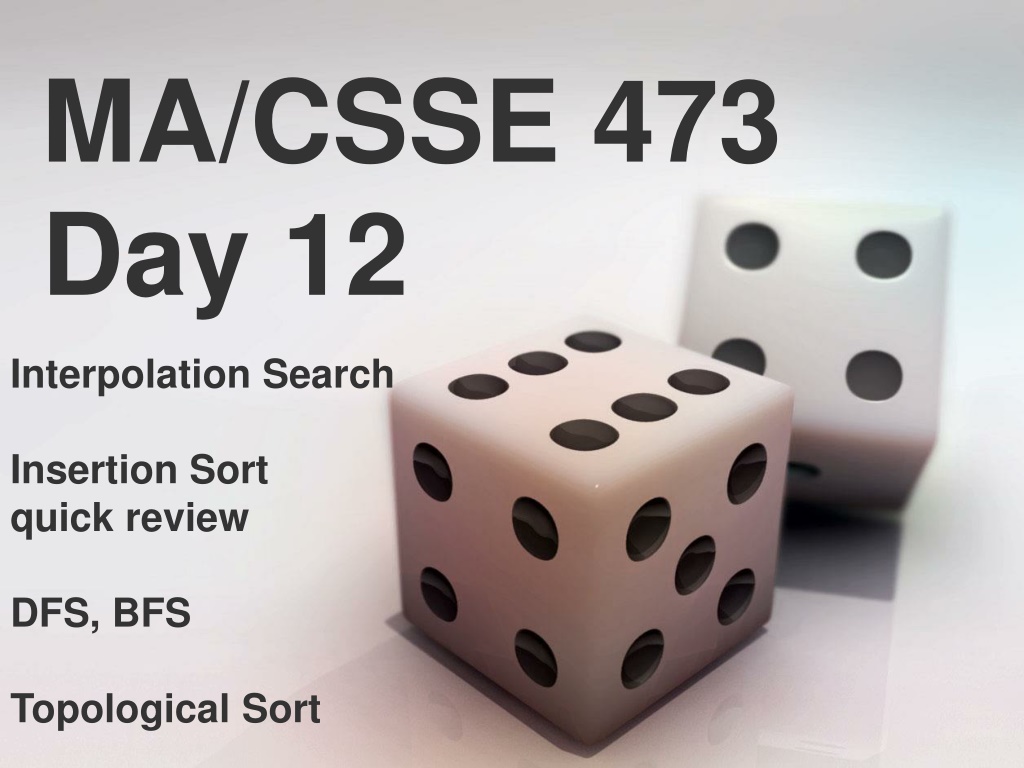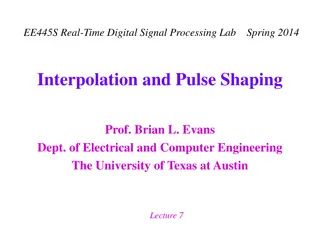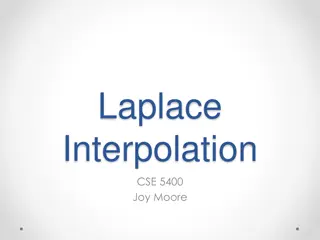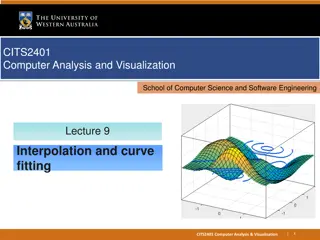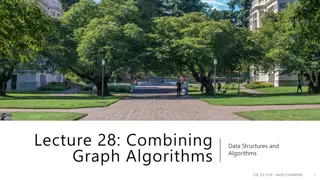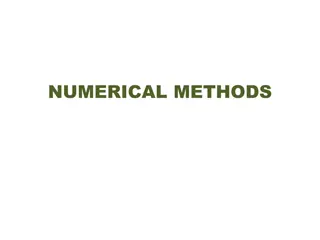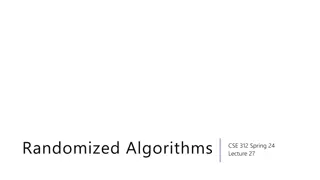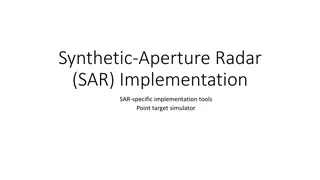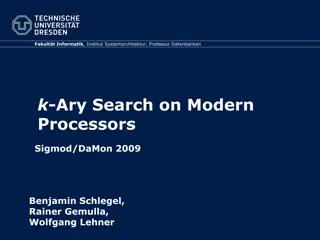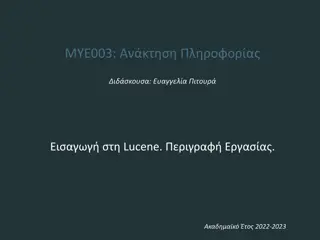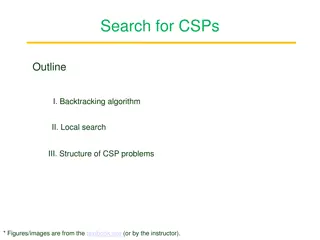Brief Overview of Interpolation Search and Algorithms
Explore Interpolation Search, variable decrease algorithms, and the efficiency of Insertion Sort. Understand the concept of decreasing by constant amount, factor or variable, and discover how interpolation search estimates the location of a key in a sorted array. Dive into the running time analysis and factors affecting worst-case behavior. Delve into various decrease-by-one algorithms like Selection Sort, DFS, and BFS. Examine the time complexity and space efficiency of Insertion Sort, introducing Binary Insertion Sort for sorted arrays.
Download Presentation

Please find below an Image/Link to download the presentation.
The content on the website is provided AS IS for your information and personal use only. It may not be sold, licensed, or shared on other websites without obtaining consent from the author.If you encounter any issues during the download, it is possible that the publisher has removed the file from their server.
You are allowed to download the files provided on this website for personal or commercial use, subject to the condition that they are used lawfully. All files are the property of their respective owners.
The content on the website is provided AS IS for your information and personal use only. It may not be sold, licensed, or shared on other websites without obtaining consent from the author.
E N D
Presentation Transcript
MA/CSSE 473 Day 12 Interpolation Search Insertion Sort quick review DFS, BFS Topological Sort
MA/CSSE 473 Day 12 Questions? Interpolation Search Insertion sort analysis Depth-first Search Breadth-first Search Topological Sort (Introduce permutation and subset generation)
Decrease and Conquer Algorithms Three variations. Decrease by constant amount constant factor variable amount
Variable Decrease Examples Euclid's algorithm b and a % b are smaller than a and b, but not by a constant amount or constant factor Interpolation search Each of he two sides of the partitioning element are smaller than n, but can be anything from 0 to n-1.
Interpolation Search Searches a sorted array similar to binary search but estimates location of the search key in A[l..r] by using its value v. Specifically, the values of the array s elements are assumed to increase linearly from A[l] to A[r] Location of v is estimated as the x-coordinate of the point on the straight line through (l, A[l]) and (r, A[r]) whose y-coordinate is v: x = l + (v - A[l])(r - l)/(A[r] A[l] ) See Weiss, section 5.6.3 Levitin Section 4.5 [5.6]
Interpolation Search Running time Average case: (log (log n)) Worst: (n) What can lead to worst-case behavior? Social Security numbers of US residents Phone book (Wilkes-Barre) CSSE department employees*, 1984-2017 *Red and blue are current employees
Some "decrease by one" algorithms Insertion sort Selection Sort Depth-first search of a graph Breadth-first search of a graph
Review: Analysis of Insertion Sort Time efficiency Cworst(n) = n(n-1)/2 (n2) Cavg(n) n2/4 (n2) Cbest(n) = n - 1 (n) (also fast on almost-sorted arrays) Space efficiency: in-place (constant extra storage) Stable: yes Binary insertion sort (HW 6) use Binary search, then move elements to make room for inserted element
Graph Traversal Many problems require processing all graph vertices (and edges) in systematic fashion Most common Graph traversal algorithms: Depth-first search (DFS) Breadth-first search (BFS)
Depth-First Search (DFS) Visits a graph s vertices by always moving away from last visited vertex to unvisited one, backtracks if no adjacent unvisited vertex is available Uses a stack a vertex is pushed onto the stack when it s reached for the first time a vertex is popped off the stack when it becomes a dead end, i.e., when there are no adjacent unvisited vertices Redraws graph in tree-like fashion (with tree edges and back edges for undirected graph) A back edge is an edge of the graph that goes from the current vertex to a previously visited vertex (other than the current vertex's parent).
Notes on DFS DFS can be implemented with graphs represented as: adjacency matrix: (V2) adjacency list: (|V|+|E|) Yields two distinct ordering of vertices: order in which vertices are first encountered (pushed onto stack) order in which vertices become dead-ends (popped off stack) Applications: checking connectivity, finding connected components checking acyclicity finding articulation points searching state-space of problems for solution (AI)
Example: DFS traversal of undirected graph a b c d e f g h DFS traversal stack: DFS tree:
Breadth-first search (BFS) Visits graph vertices in increasing order of length of path from initial vertex. Vertices closer to the start are visited early Instead of a stack, BFS uses a queue Level-order traversal of a rooted tree is a special case of BFS Redraws graph in tree-like fashion (with tree edges and cross edges for undirected graph)
Pseudocode for BFS Note that this code is like DFS, with the stack replaced by a queue
Example of BFS traversal of undirected graph a b c d e f g h BFS traversal queue: BFS tree:
Notes on BFS BFS has same efficiency as DFS and can be implemented with graphs represented as: adjacency matrices: (V2) adjacency lists: (|V|+|E|) Yields a single ordering of vertices (order added/deleted from the queue is the same) Applications: same as DFS, but can also find shortest paths (smallest number of edges) from a vertex to all other vertices
Directed graphs In an undirected graph, each edge is a "two- way street". The adjacency matrix is symmetric In an directed graph (digraph), each edge goes only one way. (a,b) and (b,a) are separate edges. One such edge can be in the graph without the other being there.
Dags and Topological Sorting dag: a directed acyclic graph, i.e. a directed graph with no (directed) cycles a b a b not a dag a dag c d c d Dags arise in modeling many problems that involve prerequisite constraints (construction projects, document version control, compilers) The vertices of a dag can be linearly ordered so that every edge's starting vertex is listed before its ending vertex (topological sort). A graph must be a dag in order for a topological sort of its vertices to be possible.
Topological Sort Example Order the following items in a food chain tiger human fish sheep shrimp plankton wheat
DFS-based Algorithm DFS-based algorithm for topological sorting Perform DFS traversal, noting the order vertices are popped off the traversal stack Reversing order solves topological sorting problem Back edges encountered? NOT a dag! Example: a b c d e f g h Efficiency:
Source Removal Algorithm Repeatedly identify and remove a source (a vertex with no incoming edges) and all the edges incident to it until either no vertex is left (problem is solved) or there is no source among remaining vertices (not a dag) Example: a b c d e f g h Efficiency: same as efficiency of the DFS-based algorithm
Application: Spreadsheet program What is an allowable order of computation of the cells' values?
(We may not get to this today) Permutations Subsets COMBINATORIAL OBJECT GENERATION
Combinatorial Object Generation Generation of permutations, combinations, subsets. This is a big topic in CS We will just scratch the surface of this subject. Permutations of a list of elements (no duplicates) Subsets of a set
Permutations We generate all permutations of the numbers 1..n. Permutations of any other collection of n distinct objects can be obtained from these by a simple mapping. How would a "decrease by 1" approach work? Find all permutations of 1.. n-1 Insert n into each position of each such permutation We'd like to do it in a way that minimizes the change from one permutation to the next. It turns out we can do it so that we always get the next permutation by swapping two adjacent elements.
First approach we might think of for each permutation of 1..n-1 for i=0..n-1 insert n in position i That is, we do the insertion of n into each smaller permutation from left to right each time However, to get "minimal change", we alternate: Insert n L-to-R in one permutation of 1..n-1 Insert n R-to-L in the next permutation of 1..n-1 Etc.
Example Bottom-up generation of permutations of 123 Example: Do the first few permutations for n=4
